Measures to combat powdery mildew on currants, if the berries have already appeared in the spring
Powdery mildew (powdery mildew, ash) is an insidious disease that can deprive a gardener of a currant harvest without treatment. The disease is caused by powdery mildew fungi. The situation is aggravated by the lightning spread of spores from one bush to another. We will tell you in detail what kind of disease this is and how to treat it.
How to recognize powdery mildew on currants
Powdery mildew is a fungal disease that affects leaves and fruits. Black currants are usually susceptible to infection. Golden, red and white rarely get sick. Fungal spores can withstand low and high air temperatures and overwinter in soil and plant debris.

Causes of bush infection:
- proximity to infected areas;
- humid and warm air;
- weeds under bushes;
- excess nitrogen in the soil;
- heavy pruning;
- dense planting.
Black currants suffer from powdery mildew 2 times a year -after flowering and during the ripening period of berries.
Symptoms:
- white coating on the tops of shoots;
- brown spots on leaves and branches;
- plant growth retardation;
- deformation and drying of shoots;
- curled and pale leaves;
- whitish coating on the berries and cessation of growth;
- deterioration of fruit taste.
During the fruiting period, powdery mildew affects berries, shoots, and fruit branches. The plant stops growing, dries, loses its protective powers, and its resistance to frost decreases.
Interesting things on the site:
Currant diseases, methods of control and prevention
Measures to combat white plaque
Measures to combat powdery mildew on currants include use of chemicals and folk remedies. The number of treatments depends on the season and growing season of the plant.
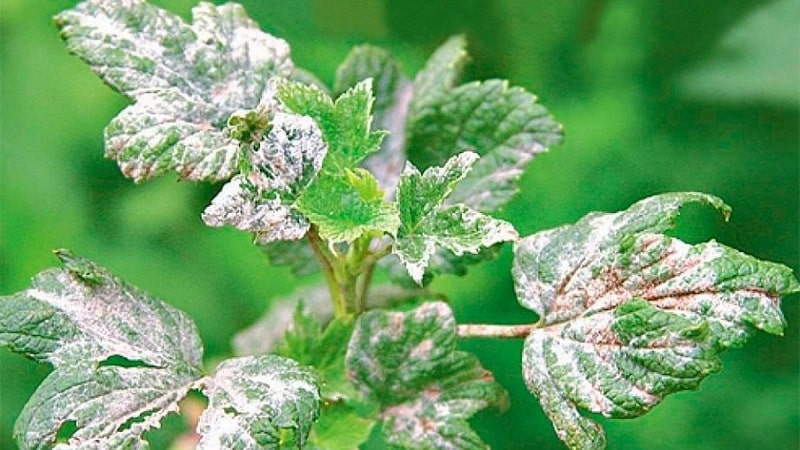
What to treat in spring
The fight against powdery mildew begins in early spring. A gardener's arsenal always includes chemicals and folk remedies. Frequent spraying with fungicides causes the fungus to become resistant. In addition, chemicals are contraindicated after the ovaries appear.
Spring treatment includes spraying bushes and tree trunks. Fungicides have different durations of action, so to prolong the therapeutic effect, the procedure is performed several times.
Before the snow melts, the tops of the shoots quickly dip into a bucket of boiling water. This method is often used in practice because it reduces the risk of infection by 60-70%.
The top layer of soil is replaced with new humus. Together with the old layer, it is possible to remove spores of the fungus overwintering in the soil.
Before the buds swell, the plants are treated with a solution of copper sulfate. and carry out moisture-charging irrigation. Before the leaves appear, it is difficult to understand whether the bushes are infected or not. Treatment begins immediately after detection of whitish spots on the greenery. The treatment is carried out 3-4 times, following the manufacturer’s recommendations.
Currant powdery mildew is treated with biofungicides and chemicals.
Biofungicides - These are biological agents that suppress the vital activity of the causative agent of the disease. They contain bacteria that destroy the shell of the fungus. The products are harmless to humans, birds and bees. Processing can be carried out at any time. Considering the short duration of action and water solubility of biological products, spraying is repeated every 5-7 days until a satisfactory result is obtained.
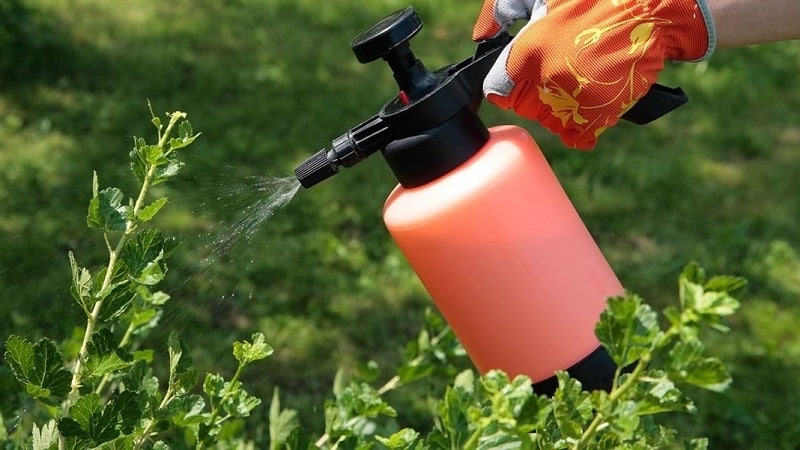
Chemicals - These are pesticides with a toxic effect on the environment, so treatments are carried out in protective clothing, gloves, goggles and a respirator. Fungicides contain heavy metals that accumulate in soil and plant tissue. Therefore, currant treatment is carried out strictly according to the instructions, observing the frequency of treatments.
Plant protection lasts longer. To destroy the fungus, 3-4 treatments per season are enough. Systemic fungicides are more effective. They protect the bushes from fungus and prevent infection. Such products are used to treat large areas. If a small area is infected with powdery mildew, protective fungicides are used. The solution envelops the leaves and shoots with a layer of active substances, does not penetrate the ovaries and leaf blades and prevents infection. The treatment is carried out in the evening, in dry, windless weather.
Reference. In spring, products with dithiocarbamic acid are used, which stimulates plant growth. In summer, preference is given to copper-containing preparations.
Metronidazole
The active ingredient is trichopolum. The antibacterial drug is available in tablets and is sold in any pharmacy. To prepare the solution, take 3 tablets per 0.5 liters of water and treat the bushes. It is recommended to carry out the first spraying before flowering, the second - in late May - early June. If after a week the symptoms have not disappeared, treatment is carried out every day until complete recovery.

Boric acid
The product is used for foliar feeding when the plant lacks boron. Processing stimulates the growth of berries, improves their taste and fleshiness.To prepare the solution, take 2 g of each substance per 10 liters of water, add 40 drops of iodine, irrigate the bushes immediately after the foliage appears and repeat during the period of flowering and ovary formation.
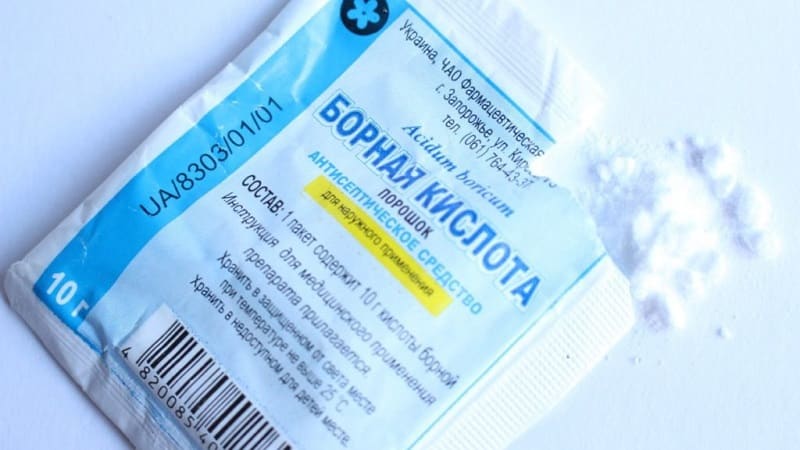
Bordeaux liquid
The solution is prepared from slaked lime, copper sulfate and water. This is a universal remedy for fighting fungal infections. The advantage of Bordeaux mixture is its long-lasting effect. One treatment per month is enough to protect against fungus. The product remains on the greenery and is not washed off with water. For prevention, currants are treated with a 1% solution in early spring before the buds begin to swell. If the bushes are partially infected, the treatment is performed 3 times: before the leaves appear, at the beginning of the growing season and after flowering. In case of mass infection, currants are sprayed up to 6 times a season. The last treatment is carried out 2-3 weeks before harvest.

Copper sulfate
To spray currants use a 1% solution. The treatment is carried out before the buds open. In case of mass infection, 4-5 treatments are carried out every 10-14 days. For better adhesion to foliage, add 50 g of laundry soap to 10 liters of solution.
"HOM"
This is a potent copper-containing drug. Currant bushes are treated with a 0.4% solution - 40 g per 10 liters of water. The product is mixed with Fufanon and Decis, 1 bottle each, for complex treatment against fungal diseases. Spraying is carried out once - before flowering.
"Skor"
Broad-spectrum chemical fungicide containing difenoconazole. The active substance inhibits the proliferation of mycelium, reduces the source of infection and completely rids the plant of powdery mildew. The effect of the drug begins 2 hours after irrigation. Rain and wind do not reduce the effectiveness of the drug. Take 2 ml of product per 10 liters of water.Preventive treatment is carried out twice with an interval of 10-12 days, therapeutic treatment - every 7 days.
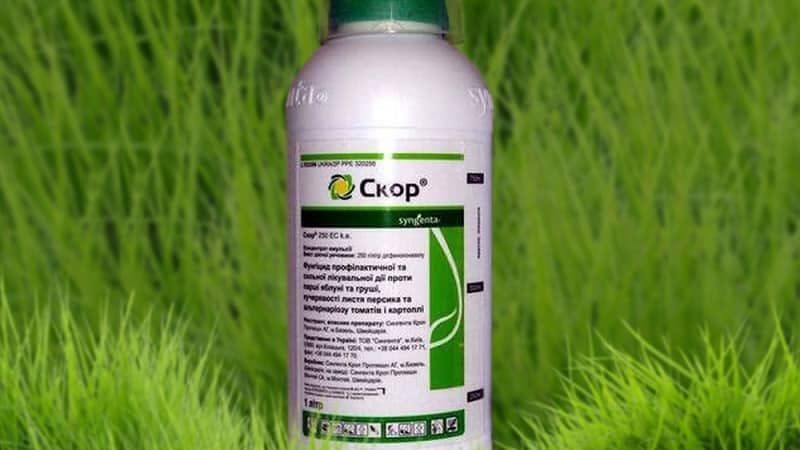
"Fitosporin"
Bacteriological biofungicide inhibits mycelial growth, used for the treatment and prevention of powdery mildew. The contents of the package are poured into a small amount of water, stirred and left for 5-6 hours. For 10 liters of water take 1 tbsp. l. suspensions and spray the currants. The treatment is carried out once - in early spring. If the bushes are sick, repeated spraying is pointless.
"Fundazol"
Fungicide containing benomyl. The active substance disrupts cell division and prevents the proliferation of fungus. The protective effect lasts 13-14 days. The product is used to treat leaves, shoots and soil. Take 1 ml of the drug per 1 liter of water. The first treatment is performed at the first symptoms of infection, the second - after 2 weeks.
"Topaz"
Fungicide containing penconazole. The drug is compatible with insecticides and other fungicides, is used sparingly, and remains effective for 2-3 weeks. The composition stops the growth of mycelium 3 hours after treatment. Take 2 ml of the product per 10 liters of water and spray the currants at the first symptoms of infection. The interval between procedures is 7-8 days. Consumption per bush - 1.5 l. The frequency of treatments is 3 times.
"Previkur"
Systemic drug containing prolamocarbofosetyl. The active substance penetrates the leaves, inhibits the growth of fungus, and stimulates the development of leaves and berries. Take 5 ml of product per 1 liter of water. The foliage and soil around the bushes are thoroughly treated with the solution. Repeated spraying - after 10-14 days.
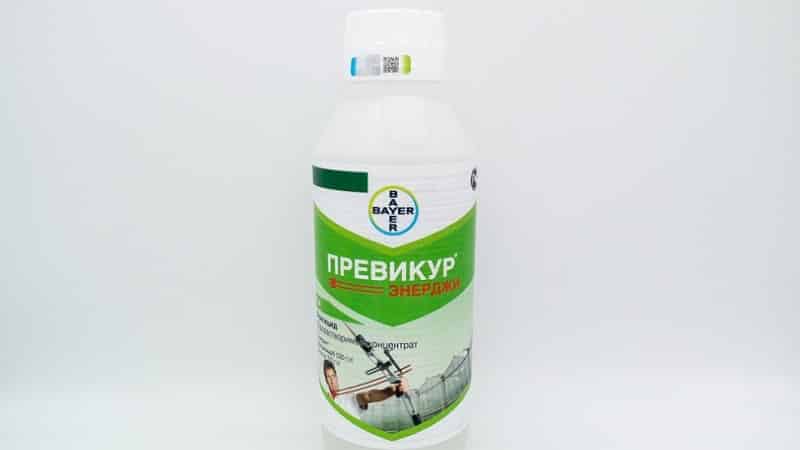
During the period of fruiting and ripening
During the period of fruiting and ripening, black currants are not recommended to be treated with fungicides. Control measures, if berries have already appeared, include the use of natural remedies, colloidal sulfur and copper sulfate. Plant treatment is carried out in dry weather.
Recipes for folk remedies:
- 1 liter of whey per 10 liters of water. The frequency of treatment of bushes is 3 times every 3 days. A milky film envelops the leaves, shoots and berries, cutting off oxygen to the mycelium.
- 2 tbsp. l. soda, 2 tbsp. l. liquid soap per 10 liters of water. Treatment frequency: 2 times with a break per week.
- 50 g of soda, 10 ml of liquid soap per 10 liters of water. The bushes are treated with the solution 2 times - before flowering and after it.
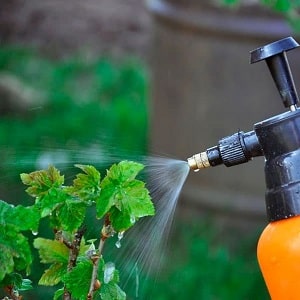 300 g of wood ash per 5 liters of water are brought to a boil, cooled, filtered and sprayed on the currants. Treatment frequency: every 10-12 days until signs of the disease completely disappear.
300 g of wood ash per 5 liters of water are brought to a boil, cooled, filtered and sprayed on the currants. Treatment frequency: every 10-12 days until signs of the disease completely disappear.- 50 g of potassium chloride, 30 g of urea, 20 g of superphosphate, 5 g of potassium permanganate per 10 liters of warm water. The solution is used for one-time spraying of bushes. It serves both as a treatment for currants and as a top dressing.
- 10 ml rapeseed oil per 10 liters of water. The solution is used for one-time spraying of bushes.
- 1 tbsp. l. soda, 1 aspirin tablet, 1 tsp. liquid soap, 1 tbsp. l. vegetable oil per 5 liters of water. The bushes are processed once, and after harvesting the berries are washed under running water.
- 30 g of soda ash, 5 g of grated laundry soap per 5 liters of water. A single treatment is sufficient.
- 100 g of horsetail greens per 1 liter of water. Leave for 24 hours, pour into a container with a spray bottle and treat the bushes.
- 5 g of copper sulfate, 30 g of grated laundry soap per 10 liters of water. Processing frequency: once.
- Treatment of bushes with cow manure diluted with water in a ratio of 1:10.
- 30 g of colloidal sulfur per 10 liters of water. Processing frequency: once.
After harvesting, the area is completely cleared of weeds and plant debris and burned.. The soil is treated with a solution of copper sulfate.
Conclusion
The success of treating white plaque on currant leaves depends on the chosen method. In mild cases, preventive spraying with Bordeaux mixture, copper sulfate or Fitosporin is sufficient. In case of mass infection, “heavy artillery” is used - chemical fungicides. Such products are allowed to be used before flowering begins.
During the ripening period of the berries, folk remedies based on baking soda and soda ash, whey, rapeseed oil, wood ash, and field ivy are used. In the fall, the area is completely cleared of debris, and in the spring the top layer of soil is replaced with a new one.